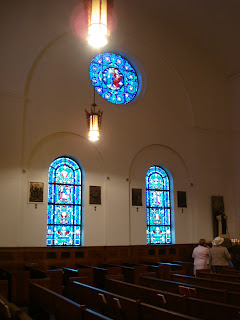This week, Dan, Loreto, and I took a trip out to the Ukrainian National Catholic Shrine of the Holy Family, a beautiful church near the Catholic University of America. The Ukrainian Catholic Church is an eastern-rite Catholic church, meaning that they are in communion with the Holy See, but are not part of the Latin Rite, which encompasses most of the Catholic Churches in the United States and around the world. Thus, members of the Ukrainian Catholic Church are Catholic, but not “Roman” Catholic. More on this later.
The church building doesn’t look like any church I’ve ever seen before. Built on a sloping hillside, the church appears to resemble some sort of military battleship. Above a few feet of vertical wall is what appears to be a giant, sloping roof, topped with golden sphires, a distinctive feature of Slavic architecture. On the inside, the church had mostly plain white walls, with several Byzantine-style icons all around. The windows located on the slanted part of the church were designed to allow the sun to shine into the church differently during the different seasons, and to shine directly on the altar one or two days of the year. There was also what appeared to be a big golden fence with several icons on it in between the altar and the congregation. During the Mass, a set of gates in the center of the fence was opened, but much of the action of the Mass was still covered from view.
The Mass was, of course, in Ukrainian, and the three of us had no idea what was going on most of the time. We tried to follow along in the bilingual liturgy guide, though it was tough to keep track of what page we were on. We kept looking over the shoulder of the gentleman sitting in front of us to see what page we should be on. There were a few things I noticed while trying to follow along. The first was that there was very little talking, and a whole lot of singing. The three priests would chant out a verse, and the congregation, along with the choir, located in a loft above the parishioners, would respond. Unaccompanied by any musicians, much of the Mass was done in this purely vocal, call-and-response form.
They did a few things that reminded me of Our Lady of Lebanon, the Maronite Catholic Church I visited last spring. The first was their use of incense at several points during the Mass. Roman Catholics generally reserve incense for special occasions. Another was the way they presented the Eucharist. Whereas most Roman Catholic Churches offer a small wafer as the body of Christ and wine as the blood of Christ, the Ukrainians offered a cube-shaped piece of bread that was soaked with wine. Mixing bread and wine, a practice known as “intinction,” is considered a big no-no in the Roman Catholic Church, but is still practiced in some Eastern churches. Rather than directly placing the Eucharist in our hands or mouths, the priests at the Shrine of the Holy Family stuck the Eucharist in our mouths with golden spoons. I joked to my friends that it was the first time I had ever been “spoon-fed” the Eucharist.
After Mass, we spoke briefly with the Grand Knight of the Holy Family’s Knights of Columbus Council, Brian. He introduced us to one of the priests, who explained some of the Ukrainian Catholic traditions and symbols. Normally, he said, the church would have icons all over the walls, but they simply didn’t have the money to put them in right away. The big golden fence in front of the altar was called an “icon screen,” and when the priests moved outside of it to distribute the Eucharist or read from the Gospel, it symbolized the way God moves toward us to awaken the spirit inside of us. Altogether, quite an interesting Mass.
Links:
Pictures:
Churches I've Been To So Far (26!)















































